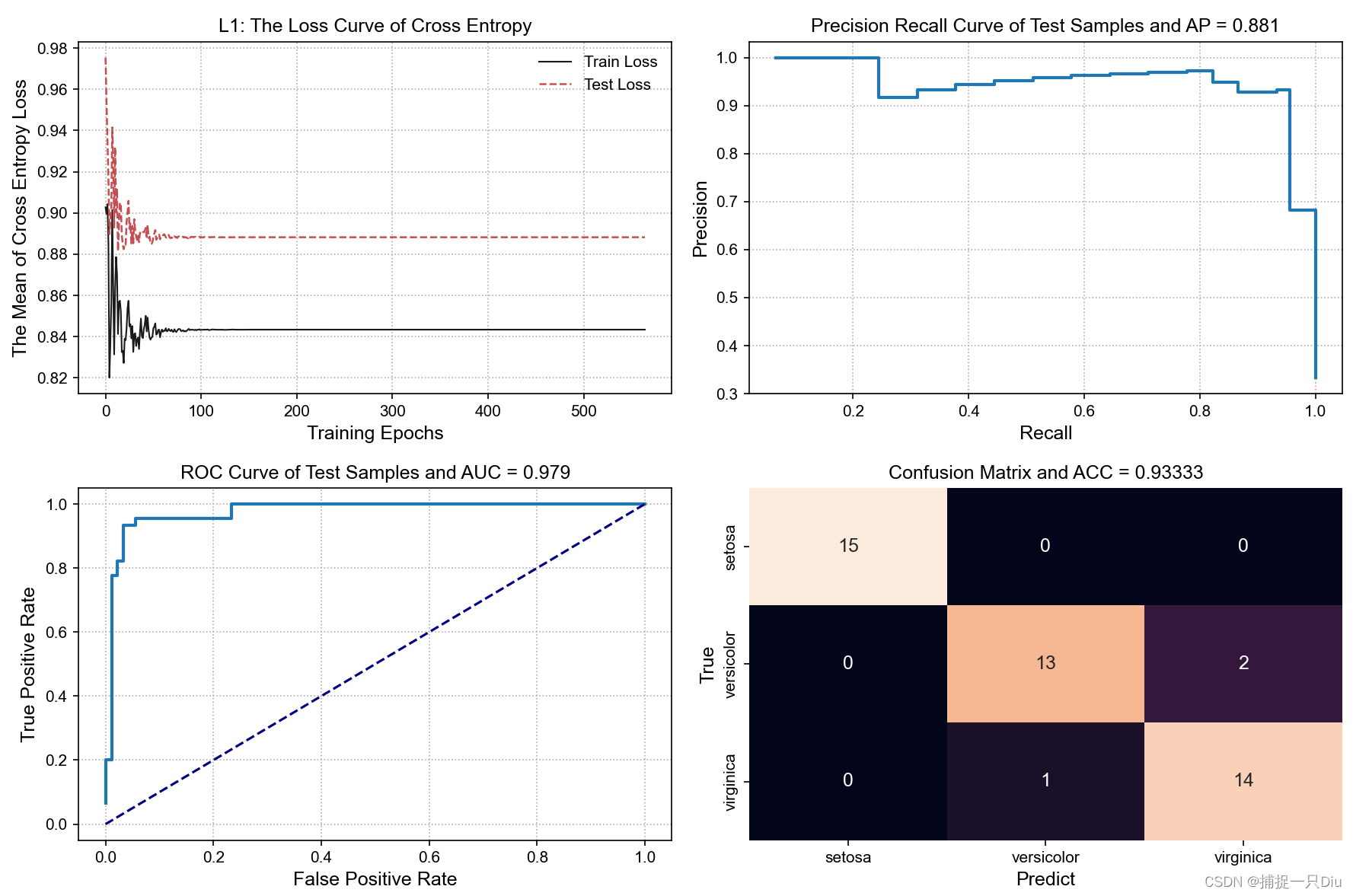Softmax回归(多分类)

logistic_regression_mulclass.py
import numpy as np
import matplotlib.pyplot as plt
class LogisticRegression_MulClass:
"""
逻辑回归,采用梯度下降算法 + 正则化,交叉熵损失函数,实现多分类,Softmax函数
"""
def __init__(self, fit_intercept=True, normalize=True, alpha=0.05, eps=1e-10,
max_epochs=300, batch_size=20, l1_ratio=None, l2_ratio=None, en_rou=None):
"""
:param eps: 提前停止训练的精度要求,按照两次训练损失的绝对值差小于eps,停止训练
:param fit_intercept: 是否训练偏置项
:param normalize: 是否标准化
:param alpha: 学习率
:param max_epochs: 最大迭代次数
:param batch_size: 批量大小,若为1,则为随机梯度,若为训练集样本量,则为批量梯度,否则为小批量梯度
:param l1_ratio: LASSO回归惩罚项系数
:param l2_ratio: 岭回归惩罚项系数
:param en_rou: 弹性网络权衡L1和L2的系数
"""
self.fit_intercept = fit_intercept # 线性模型的常数项。也即偏置bias,模型中的theta0
self.normalize = normalize # 是否标准化数据
self.alpha = alpha # 学习率
self.eps = eps # 提前停止训练
if l1_ratio:
if l1_ratio < 0:
raise ValueError("惩罚项系数不能为负数")
self.l1_ratio = l1_ratio # LASSO回归惩罚项系数
if l2_ratio:
if l2_ratio < 0:
raise ValueError("惩罚项系数不能为负数")
self.l2_ratio = l2_ratio # 岭回归惩罚项系数
if en_rou:
if en_rou > 1 or en_rou < 0:
raise ValueError("弹性网络权衡系数范围在[0, 1]")
self.en_rou = en_rou # 弹性网络权衡L1和L2的系数
self.max_epochs = max_epochs
self.batch_size = batch_size
self.theta = None # 训练权重系数
if normalize:
self.feature_mean, self.feature_std = None, None # 特征的均值,标准方差
self.n_samples, self.n_classes = 0, 0 # 样本量和类别数
self.train_loss, self.test_loss = [], [] # 存储训练过程中的训练损失和测试损失
def init_theta_params(self, n_features, n_classes):
"""
初始化参数
如果训练偏置项,也包含了bias的初始化
:param n_features: 样本的特征数量
:param n_classes: 类别数
:return: n_features * n_classes
"""
self.theta = np.random.randn(n_features, n_classes) * 0.05
@staticmethod
def one_hot_encoding(target):
"""
类别编码
:param target:
:return:
"""
class_labels = np.unique(target) # 类别标签,去重
target_y = np.zeros((len(target), len(class_labels)), dtype=np.int64)
for i, label in enumerate(target):
target_y[i, label] = 1 # 对应类别所在列为1
return target_y
@staticmethod
def softmax_func(x):
"""
softmax函数,为避免上溢或下溢,对参数x做限制
:param x: 数组: batch_size * n_classes
:return: 1 * n_classes
"""
exps = np.exp(x - np.max(x)) # 避免溢出,每个数减去其最大值
exp_sum = np.sum(exps, axis=1, keepdims=True)
return exps / exp_sum
@staticmethod
def sign_func(z_values):
"""
符号函数,针对L1正则化
:param z_values: 模型系数,二维数组
:return:
"""
sign = np.zeros(z_values.shape)
sign[z_values > 0] = 1.0
sign[z_values < 0] = -1.0
return sign
@staticmethod
def cal_cross_entropy(y_test, y_prob):
"""
计算交叉熵损失
:param y_test: 样本真值,二维数组n * c,c表示类别数
:param y_prob: 模型预测类别概率,n * c
:return:
"""
loss = -np.sum(y_test * np.log(y_prob + 1e-08), axis=1)
loss -= np.sum((1 - y_test) * np.log(1 - y_prob + 1e-08), axis=1)
return np.mean(loss)
def fit(self, x_train, y_train, x_test=None, y_test=None):
"""
样本的预处理,模型系数的求解,闭式解公式 + 梯度方法
:param x_train: 训练样本集 m*k
:param y_train: 训练目标集 m*c
:param x_test: 测试样本集 n*k
:param y_test: 测试目标集 n*c
:return:
"""
y_train = self.one_hot_encoding(y_train)
self.n_classes = y_train.shape[1] # 类别数
if y_test is not None:
y_test = self.one_hot_encoding(y_test)
if self.normalize:
self.feature_mean = np.mean(x_train, axis=0) # 样本均值
self.feature_std = np.std(x_train, axis=0) + 1e-8 # 样本方差
x_train = (x_train - self.feature_mean) / self.feature_std # 标准化
if x_test is not None:
x_test = (x_test - self.feature_mean) / self.feature_std # 标准化
if self.fit_intercept:
x_train = np.c_[x_train, np.ones((len(y_train), 1))] # 添加一列1,即偏置项样本
if x_test is not None and y_test is not None:
x_test = np.c_[x_test, np.ones((len(y_test), 1))] # 添加一列1,即偏置项样本
self.init_theta_params(x_train.shape[1], self.n_classes) # 初始化参数
# 训练模型
self._fit_gradient_desc(x_train, y_train, x_test, y_test) # 梯度下降法训练模型
def _fit_gradient_desc(self, x_train, y_train, x_test=None, y_test=None):
"""
三种梯度下降求解 + 正则化:
(1)如果batch_size为1,则为随机梯度下降法
(2)如果batch_size为样本量,则为批量梯度下降法
(3)如果batch_size小于样本量,则为小批量梯度下降法
:return:
"""
train_sample = np.c_[x_train, y_train] # 组合训练集和目标集,以便随机打乱样本
# np.c_水平方向连接数组,np.r_竖直方向连接数组
# 按batch_size更新theta,三种梯度下降法取决于batch_size的大小
for epoch in range(self.max_epochs):
self.alpha *= 0.95
np.random.shuffle(train_sample) # 打乱样本顺序,模拟随机化
batch_nums = train_sample.shape[0] // self.batch_size # 批次
for idx in range(batch_nums):
# 取小批量样本,可以是随机梯度(1),批量梯度(n)或者是小批量梯度(<n)
batch_xy = train_sample[self.batch_size * idx: self.batch_size * (idx + 1)]
# 分取训练样本和目标样本,注意目标值不再是一列
batch_x, batch_y = batch_xy[:, :x_train.shape[1]], batch_xy[:, x_train.shape[1]:]
# 计算权重更新增量,包含偏置项
y_prob_batch = self.softmax_func(batch_x.dot(self.theta)) # 小批量的预测概率
# 1 * n <--> n * k = 1 * k --> 转置 k * 1
delta = ((y_prob_batch - batch_y).T.dot(batch_x) / self.batch_size).T
# 计算并添加正则化部分,不包含偏置项,最后一列是偏置项
dw_reg = np.zeros(shape=(x_train.shape[1] - 1, self.n_classes))
if self.l1_ratio and self.l2_ratio is None:
# LASSO回归,L1正则化
dw_reg = self.l1_ratio * self.sign_func(self.theta[:-1, :])
if self.l2_ratio and self.l1_ratio is None:
# Ridge回归,L2正则化
dw_reg = 2 * self.l2_ratio * self.theta[:-1, :]
if self.en_rou and self.l1_ratio and self.l2_ratio:
# 弹性网络
dw_reg = self.l1_ratio * self.en_rou * self.sign_func(self.theta[:-1, :])
dw_reg += 2 * self.l2_ratio * (1 - self.en_rou) * self.theta[:-1, :]
delta[:-1, :] += dw_reg / self.batch_size # 添加了正则化
self.theta = self.theta - self.alpha * delta
# 计算训练过程中的交叉熵损失值
y_train_prob = self.softmax_func(x_train.dot(self.theta)) # 当前迭代训练的模型预测概率
train_cost = self.cal_cross_entropy(y_train, y_train_prob) # 训练集的交叉熵损失
self.train_loss.append(train_cost) # 交叉熵损失均值
if x_test is not None and y_test is not None:
y_test_prob = self.softmax_func(x_test.dot(self.theta)) # 当前测试样本预测概率
test_cost = self.cal_cross_entropy(y_test, y_test_prob)
self.test_loss.append(test_cost) # 交叉熵损失均值
# 两次交叉熵损失均值的差异小于给定的均值,提前停止训练
if epoch > 10 and (np.abs(self.train_loss[-1] - self.train_loss[-2])) <= self.eps:
break
def get_params(self):
"""
返回线性模型训练的系数
:return:
"""
if self.fit_intercept: # 存在偏置项
weight, bias = self.theta[:-1, :], self.theta[-1, :]
else:
weight, bias = self.theta, np.array([0])
if self.normalize: # 标准化后的系数
weight = weight / self.feature_std.reshape(-1, 1) # 还原模型系数
bias = bias - weight.T.dot(self.feature_mean)
return weight, bias
def predict_prob(self, x_test):
"""
预测测试样本的概率,第1列为y = 0的概率,第2列是y = 1的概率
:param x_test: 测试样本,ndarray:n * k
:return:
"""
if self.normalize:
x_test = (x_test - self.feature_mean) / self.feature_std # 测试数据标准化
if self.fit_intercept:
# 存在偏置项,加一列1
x_test = np.c_[x_test, np.ones(shape=x_test.shape[0])]
y_prob = self.softmax_func(x_test.dot(self.theta))
return y_prob
def predict(self, x):
"""
预测样本类别
:param x: 预测样本
:return:
"""
y_prob = self.predict_prob(x)
# 对应每个样本中所有类别的概率,哪个概率大,返回哪个类别所在索引列编号,即类别
return np.argmax(y_prob, axis=1)
def plt_loss_curve(self, lab=None, is_show=True):
"""
可视化交叉熵损失曲线
:param is_show: 是否可视化
:return:
"""
if is_show:
plt.figure(figsize=(8, 6))
plt.plot(self.train_loss, "k-", lw=1, label="Train Loss")
if self.test_loss:
plt.plot(self.test_loss, "r--", lw=1.2, label="Test Loss")
plt.xlabel("Training Epochs", fontdict={"fontsize": 12})
plt.ylabel("The Mean of Cross Entropy Loss", fontdict={"fontsize": 12})
plt.title("%s: The Loss Curve of Cross Entropy" % lab)
plt.legend(frameon=False)
plt.grid(ls=":")
# plt.axis([0, 300, 20, 30])
if is_show:
plt.show()
test_logistic_reg_mulclass.py
from sklearn.datasets import load_breast_cancer, load_iris, load_digits
from sklearn.model_selection import train_test_split
from logistic_regression_mulclass import LogisticRegression_MulClass
import matplotlib.pyplot as plt
from performance_metrics import ModelPerformanceMetrics
from sklearn.preprocessing import StandardScaler
iris = load_iris() # 加载数据集
X, y = iris.data, iris.target
X = StandardScaler().fit_transform(X) # 标准化
X_train, X_test, y_train, y_test = train_test_split(X, y, test_size=0.3, random_state=0, stratify=y)
lg_lr = LogisticRegression_MulClass(alpha=0.5, l1_ratio=0.5,
batch_size=5, normalize=False, max_epochs=1000, eps=1e-15)
lg_lr.fit(X_train, y_train, X_test, y_test)
print("L1正则化模型参数如下:")
theta = lg_lr.get_params()
fn = iris.feature_names
for i, w in enumerate(theta[0]):
print(fn[i], ":", w)
print("theta0:", theta[1])
print("=" * 70)
y_test_prob = lg_lr.predict_prob(X_test) # 预测概率
y_test_labels = lg_lr.predict(X_test)
plt.figure(figsize=(12, 8))
plt.subplot(221)
lg_lr.plt_loss_curve(lab="L1", is_show=False)
pm = ModelPerformanceMetrics(y_test, y_test_prob)
print(pm.cal_classification_report())
pr_values = pm.precision_recall_curve() # PR指标值
plt.subplot(222)
pm.plt_pr_curve(pr_values, is_show=False) # PR曲线
roc_values = pm.roc_metrics_curve() # ROC指标值
plt.subplot(223)
pm.plt_roc_curve(roc_values, is_show=False) # ROC曲线
plt.subplot(224)
cm = pm.cal_confusion_matrix()
pm.plt_confusion_matrix(cm, label_names=iris.target_names, is_show=False)
plt.tight_layout()
plt.show()
























 7784
7784











 被折叠的 条评论
为什么被折叠?
被折叠的 条评论
为什么被折叠?










